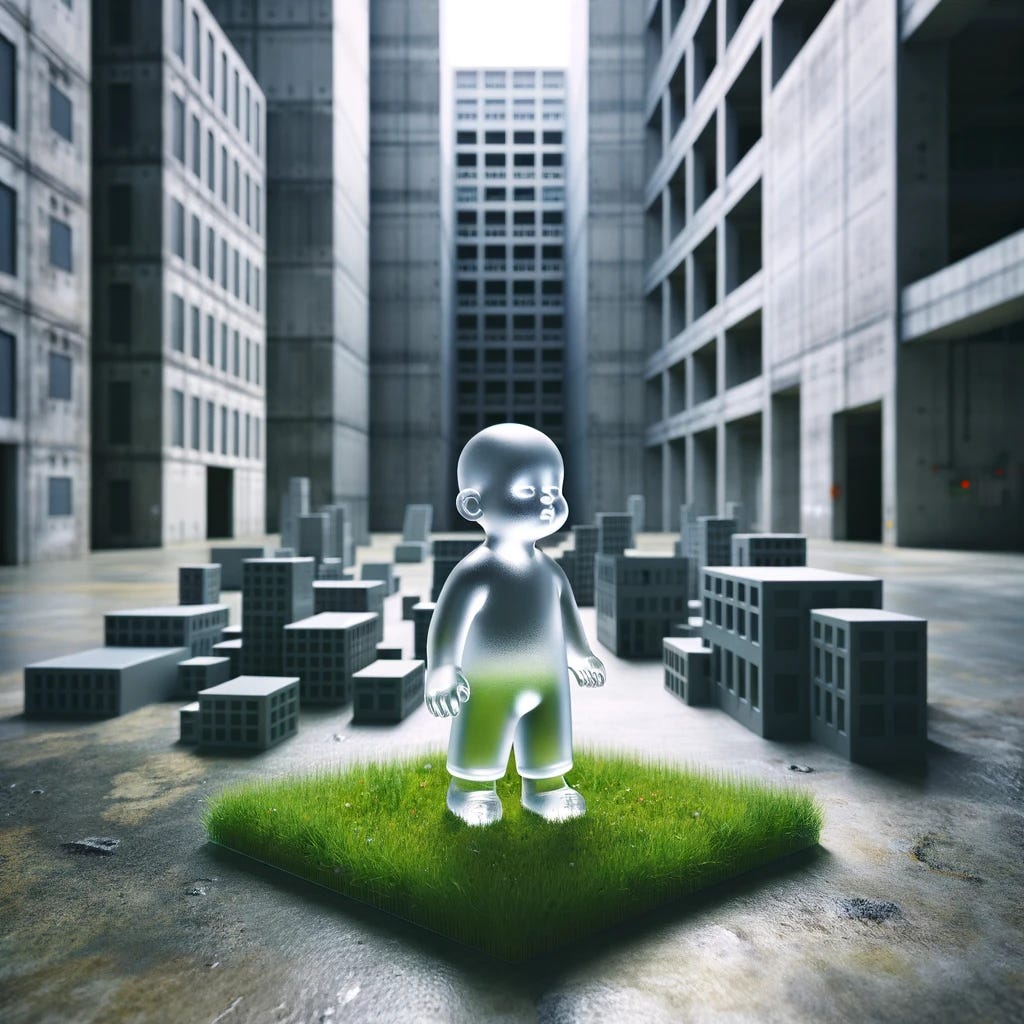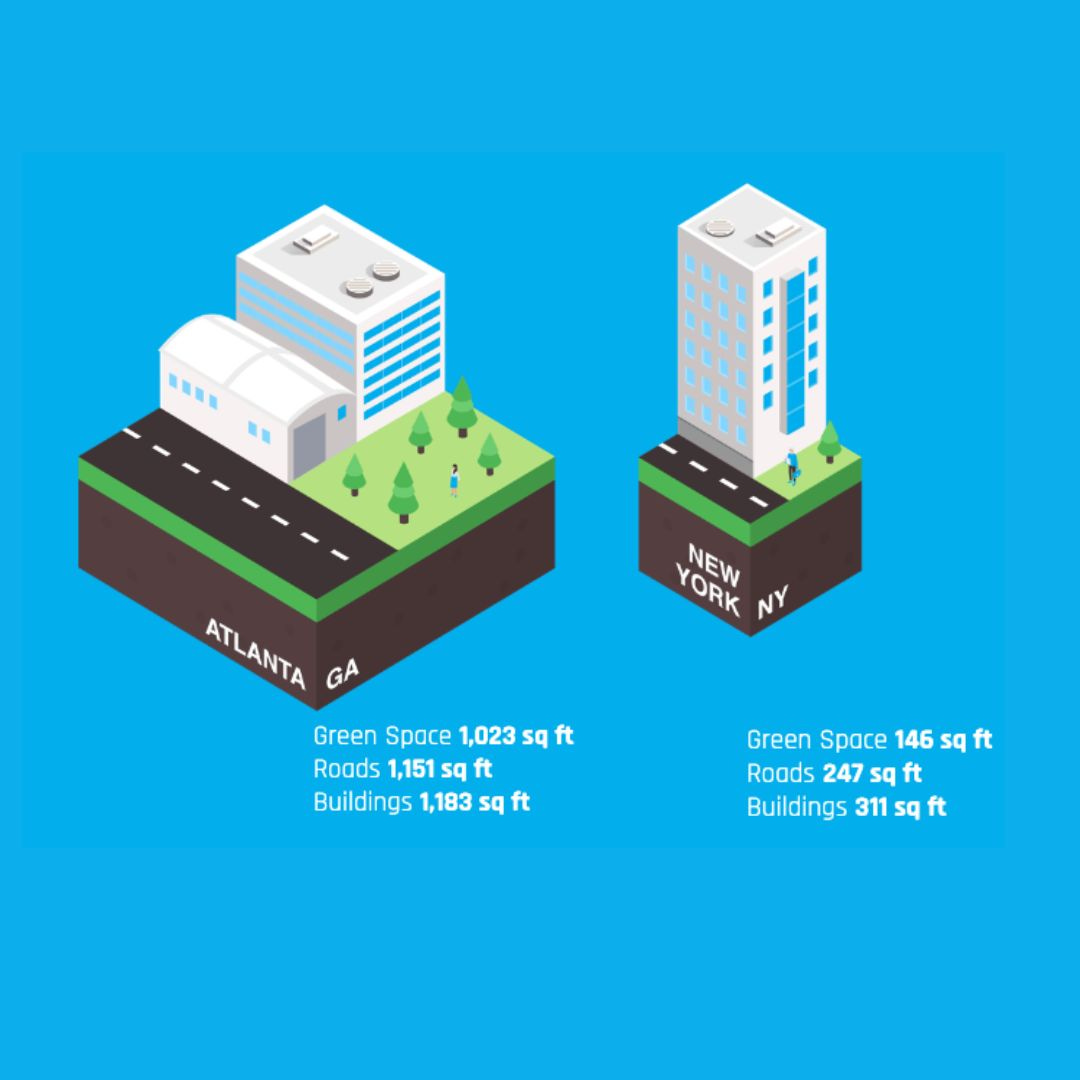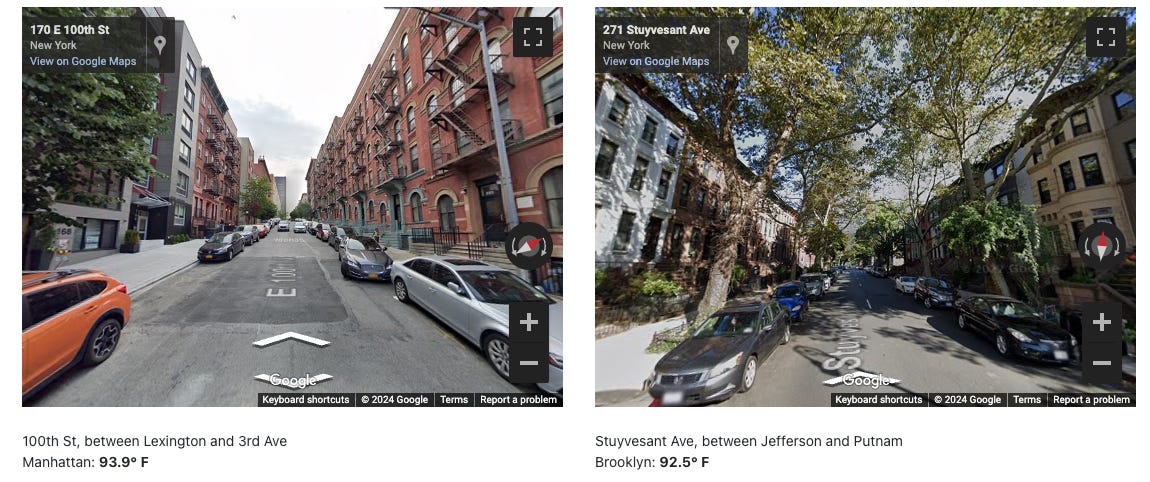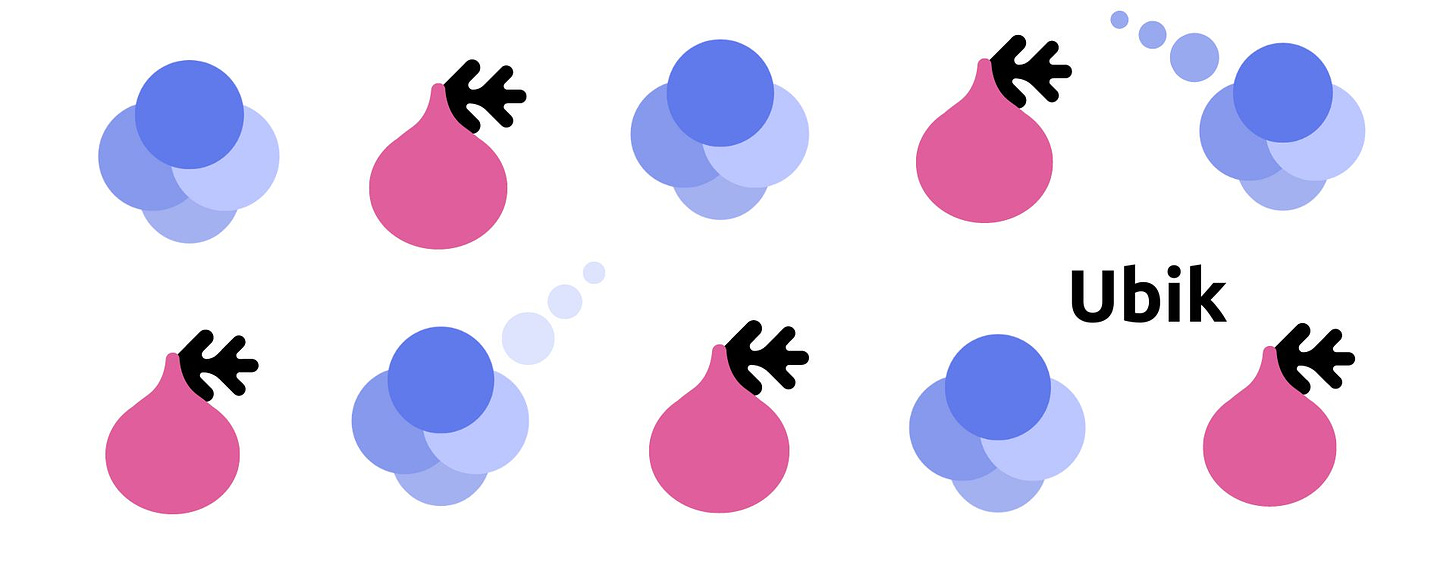- Published on
Stuck in Grey Spaces
Welcome to the Ubik Blog!
If you still need to subscribe, subscribe here!
Stuck in Grey Spaces
 Generated with ChatGPT4 — Prompt: translucent plastic standing on a small patch of grass boy stuck in a grey concrete jungle
Generated with ChatGPT4 — Prompt: translucent plastic standing on a small patch of grass boy stuck in a grey concrete jungle
We used to say that if Prospect Park were a video game, we'd have over 1000 days played. That's 24,000 hours immersed in green spaces, and it showed. We knew every hidden nook, every water fountain, and every path—five hundred twenty-six acres of maze where we felt at home—a collective backyard.
I remember those adventures. We were pioneers, braving ten-degree nights to traverse the frozen pond, stepping on islands otherwise inaccessible without a boat—or, in our case, ice. We spent hot summer nights in the grass, surrounded by friends, laughter, and music in the dark heat.
It wasn't until moving out that I realized how vital the park was to my mental health and upbringing. Some friends who had moved further into Brooklyn complained that expansive parks like Prospect Park, Central Park, and Marine Park were inaccessible from their new apartments. The parks they could walk to were technically parks, but they felt ripped off by the cement floor and chain link fences. They felt stuck in "Grey Spaces."
A Need For Green
 Graphic from Geotab study on Allocation of Space in US Cities.
Graphic from Geotab study on Allocation of Space in US Cities.
In a study by Geotab exploring the allocation of green space in US cities, New York City came last with 146 sq ft per person. 146 sq ft may seem like a lot to New Yorkers, but as shown in the picture above, Atlanta has nearly seven times more Green Space per person. The main difference here is population. Atlanta is called home by 496,421 people; here in NYC, we have just under 8.5 million. Constant growth leads to a continuous subtraction of space. Looking outside of the US, a study by the GiGL (Greenspace Information for Greater London CIC) found that nearly 47% of Greater London is Green Spaces. However, only 14% of NYC has green space, and access to parks in low-income areas is 21% lower than in high-income areas (Kirabruno, 2022).
Green Space and Health
Limited access to Green Spaces affects mental health. In low-income areas with fewer Green Spaces, mental health issues are already prevalent (Nieuwenhuijsen, 2021); by not providing communities with fair access to Green Spaces, we perpetuate these problems by keeping them in "Grey Spaces."
This toxic relationship with concrete fields and brick trees is bad for you; research shows that regular exposure to nature has health benefits, both physical and mental. A study by Matthew P. White found that when people spent 120 minutes a week in nature, they found health benefits and a better state of well-being, and 120 minutes was nothing. That's only 17 minutes daily—a short walk in the Green.
All sorts of health improvements can be associated with time spent in Green Spaces. A 2021 Barcelona Institute for Global Health study shows time in green spaces correlates with "lower premature mortality, longer life expectancy, fewer mental health problems, less cardiovascular disease, better cognitive functioning in children and the elderly, and healthier babies"(Nieuwenhuijsen, 2021)
UNICEF says equal access to Green Spaces is critical to children's development, linking improved cognitive development with access to Green Spaces around the home or school. Some studies find that greener window views improve concentration, academic performance, and overall intellectual development (Sugar, n.d.).
Painting Grey Spaces Green
 Generated with ChatGPT 4, Prompt: Translucent boy wearing full nike tech outfit painting the grey concrete city green.
Generated with ChatGPT 4, Prompt: Translucent boy wearing full nike tech outfit painting the grey concrete city green.
Fortunately, New York City has finally acknowledged its bleak grey spaces. Numerous initiatives are underway to reclaim the grey and paint it green. The Mayor's Office of Climate & Environmental Justice has collaborated with NYC's Parks and Recreation team to advance equity and park access. They aim to have "85% of New Yorkers within walking distance of a park by 2030" (NYC Mayor's Office of Climate and Environmental Justice, 2022). In 2014, the Community Parks Initiative (CPI) was the first "equity-driven parks initiative in NYC. CPI used data-driven processes to invest over $300 million in rebuilding and reimagining parks in low-income areas, amounting to 70 acres of new Green Space, opening up access to nearly half a million people.
 Picture from NYC.Gov showing examples of the Urban Heat Island Effect and importance of canopy coverage.
Picture from NYC.Gov showing examples of the Urban Heat Island Effect and importance of canopy coverage.
Tree canopies provide natural shade that decreases temperatures in overpopulated, glass-filled cities. In urban environments, temperature varies from block to block. Depending on the canopy coverage and window position, your apartment may always be hotter than someone in the house behind yours. Cities vary in architecture, population density, amount of glass, and many more factors that create the urban heat island effect, a phenomenon caused by poor city planning and a lack of green space (Environmental Protection Agency, n.d.).
Green spaces in cities do more than provide a peaceful escape from urban life; they're essential for tackling environmental challenges. Parks and gardens absorb pollutants and release oxygen, significantly improving air quality and acting as natural air filters. These areas also serve as crucial habitats for wildlife, maintaining biodiversity in cities where concrete and asphalt dominate. Urban green spaces ensure that nature thrives even in the city's heart by offering a home to various bird species, insects, and small mammals.
More Work to be Done
Reflecting on my Brooklyn youth, the vibrant days spent in Prospect Park starkly contrast with the "Grey Spaces" many urban dwellers face. These disparities in green space access mirror social inequalities and significantly affect our wellbeing. While the Mayor's Office of Climate & Environmental Justice and the Community Parks Initiative (CPI) are making strides, City Officials have more work to do. Green spaces should be a universal right, not a luxury, nurturing healthier and more inclusive communities. We should aim to guarantee everyone can enjoy and flourish in the natural world.
Work Cited
Environmental Protection Agency. (n.d.). Reduce urban heat island effect. EPA. https://www.epa.gov/green-infrastructure/reduce-urban-heat-island-effect. Accessed March 8, 2024.
Geotab. (2019). Urban footprint. https://www.geotab.com/urban-footprint/
Kirabruno. (2022, May 10). NYC green spaces: A health necessity few can enjoy. The Bard CEP Eco Reader. https://www.bard.edu/cep/blog/?p=13671
Nieuwenhuijsen, M. J. (2021, October 28). Why more green space is essential for cities. ISGLOBAL - Barcelona Institute for Global Health. https://www.isglobal.org/en/healthisglobal/-/custom-blog-portlet/why-more-green-space-is-essential-for-cities/4735173/0#:~:text=Green%20space%20can%20improve%20ecosystems,t%20get%20the%20health%20benefits
NYC Mayor's Office of Climate and Environmental Justice. (2022, October 25). Green space. https://climate.cityofnewyork.us/subtopics/green-space/
Sugar, S. (n.d.). The necessity of urban green space for children's optimal development. UNICEF. https://www.unicef.org/documents/necessity-urban-green-space-childrens-optimal-development. Accessed March 7, 2024.
White, M. P., Alcock, I., Grellier, J., Wheeler, B. W., Hartig, T., Warber, S. L., Bone, A., Depledge, M. H., & Fleming, L. E. (2019). Spending at least 120 minutes a week in nature is associated with good health and wellbeing. Nature News , Nature Publishing Group. https://www.nature.com/articles/s41598-019-44097-3
Here’s some important stuff you should check out :)
How AI is helping advance women’s health around the world
Nasa’s plans to start building hypersonic commercial airplanes
Check out our AI Education tool here:
Fiig.ai by Ubik
Fiig.ai from Ubik Studio is an academic tool that helps humans collaborate with AI to understand research without sacrificing learning. At Ubik, we aim to create ethical AI tools that impact positively.
Join us
After making an account at fiig.ai, users can:
SEARCH peer-reviewed journals
Get help using AI studies findings to PLAN projects
COLLABORATE with AI to finalize reports (with citations)
